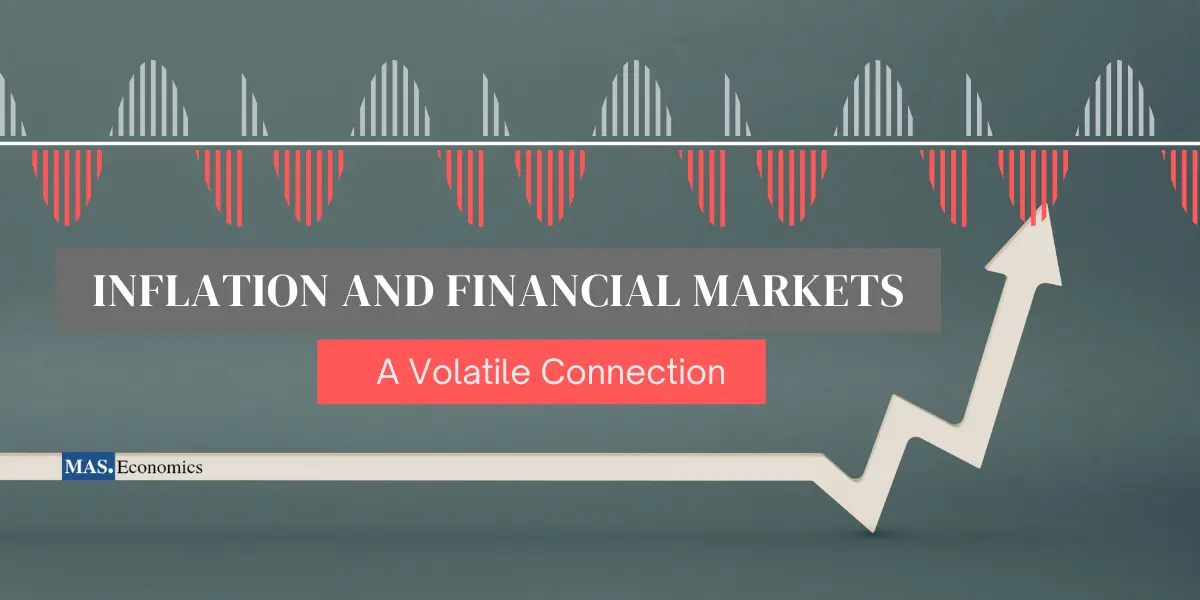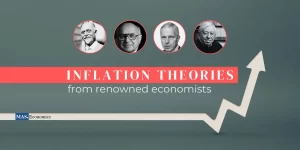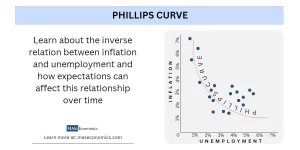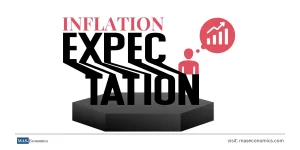Welcome to MASEconomics, your trusted source for insights into the complex world of economics. Inflation, the gradual increase in the overall price level of goods and services, holds a pivotal role in economics. While mild inflation signals economic vitality, excessive inflation can harm economies.
In this article, we explore the dynamic relationship between inflation and financial markets. We will delve deep into how inflation impacts stock markets, bond markets, and commodities. Moreover, we will uncover the pivotal roles played by narratives and central banks in shaping the very foundations of these financial landscapes.
Let’s delve into each one in-depth.
The Basics of Inflation and Financial Markets
Financial markets encompass many assets, including stock, bond, and commodity markets. Each of these markets reacts differently to inflation:
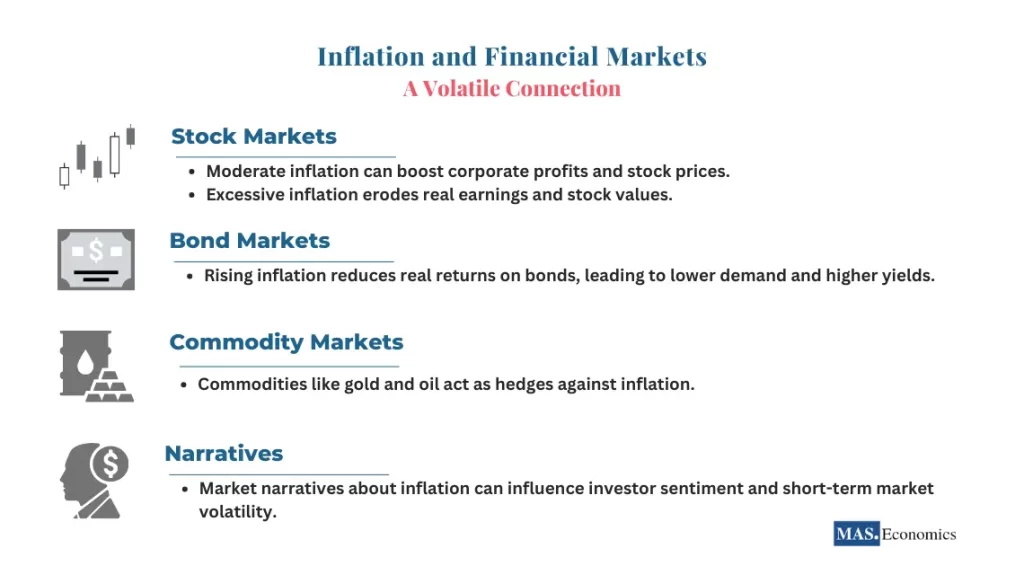
Stock Markets
In general, stock markets tend to dislike high inflation. This aversion arises from the belief that rising prices erode the real value of corporate earnings and consumer purchasing power, ultimately affecting corporate profits and stock prices. However, the relationship between inflation and stocks is nuanced and can vary based on several factors:
Inflation Rate
The rate of inflation plays a significant role. Mild inflation, within a specific range, is generally seen as a sign of economic growth. It can boost corporate revenues and profits, potentially leading to higher stock prices. However, when inflation becomes excessive, it can erode the real value of corporate earnings and consumer purchasing power, ultimately affecting corporate profits and stock prices negatively.
Economic Environment
The overall economic environment also matters. Inflation during periods of robust economic growth may be less concerning to investors than inflation in a stagnant or recessionary economy. In the former, companies may have more room to pass on cost increases to consumers, while in the latter, rising costs can squeeze profit margins.
Central Bank Policies
Central bank policies, especially regarding interest rates, are crucial in shaping stock market reactions to inflation. Central banks raising interest rates to combat inflation can put downward pressure on stock prices. Conversely, accommodative monetary policies stimulating economic activity can support stock markets during rising inflation.
Bond Markets
Bond prices and yields move inversely. When inflation rises, the real return on bonds (adjusted for inflation) may decrease, leading to lower demand for existing bonds and potentially higher yields on new bonds. This can affect both government and corporate bonds.
Inverse Relationship
Bond prices and yields move inversely. When inflation rises, the real return on bonds (adjusted for inflation) may decrease, leading to lower demand for existing bonds and potentially higher yields on new bonds. This inverse relationship can lead to bond market volatility during inflationary periods.
Commodity Markets
Commodities, including precious metals like gold and industrial resources like oil, often act as hedges against inflation. When inflation is anticipated or realized, investors may flock to commodities as a store of value, potentially driving up their prices.
Hedging Against Inflation
When inflation is anticipated or realized, investors may flock to commodities as a store of value. Precious metals like gold have historically been seen as a haven during inflationary periods. Additionally, industrial commodities like oil may see increased demand as their prices are influenced by supply and demand dynamics and, to some extent, inflation expectations.
Gold
Often referred to as a “safe-haven” asset, gold has historically been sought after during periods of inflationary pressure. Investors view gold as a store of value that can protect their wealth from the eroding effects of inflation.
Oil
The price of oil is intricately linked to inflation. Rising oil prices can contribute to higher transportation costs and production expenses, leading to price increases for a wide range of goods and services. Consequently, oil prices often surge during inflationary periods.
The Role of Narratives
Narratives play a crucial role in shaping market sentiment and investor behavior. They encompass stories, perceptions, and expectations about economic conditions and future outcomes. One hypothesis is that narratives about inflation are deeply intertwined with financial market expectations and outcomes.
Measuring Narratives
Narratives can be measured in a variety of ways, including:
| Method | Description |
|---|---|
| Sentiment Analysis | Identifies the emotional tone of the writing. For example, a news article that uses words like “crisis” and “uncertainty” would be considered to have a negative sentiment, while an article that uses terms like “recovery” and “prosperity” would be deemed to have a positive sentiment. |
| Topic Modeling | Identifies the underlying topics that are discussed in a text. For example, an article about inflation might be classified as a “macroeconomic” topic, while an article about a company’s earnings might be classified as a “corporate earnings” topic. |
| Network Analysis | Identifies the relationships between different entities, such as people, organizations, or ideas. For example, an analysis of social media posts about inflation might reveal that certain politicians or economists are more influential than others in shaping public opinion. |

| |
Predicting Market Movements
The predictive power of narratives on market movements remains a topic of debate. Some studies suggest that narratives can forecast short-term market volatility, while others find no significant relationship. However, there is growing evidence that narratives can influence investor sentiment and, subsequently, market prices.
One approach to using narratives for predictions involves monitoring word or phrase frequency in news articles, social media posts, or other sources. For instance, an increase in the frequency of the word “inflation” may signal rising investor concerns, potentially leading to lower stock prices.
Another method is tracking media sentiment. If media coverage predominantly features negative news about inflation, it might indicate growing economic pessimism among investors, potentially resulting in lower stock prices.
It’s worth emphasizing that narratives are just one factor influencing market movements. Economic fundamentals and central bank policies also play critical roles. Nevertheless, narratives can be a valuable tool for investors seeking an edge in dynamic markets.
Market Volatility
The connection between narratives and market volatility is more pronounced. Inflation and interest rate narratives can influence short-term market volatility, with higher narrative intensity associated with increased volatility. This suggests that narratives about inflation can lead to more turbulent market conditions.
Longer-Term Implications
While narratives can impact short-term market movements, their long-term effects are influenced by broader economic factors, government policies, and central bank actions.
Historical Context
To gain a deeper understanding of the interplay between expectations, narratives, and financial markets, it’s instructive to examine historical contexts.
| Historical Context | Narratives | Impact on Financial Markets |
|---|---|---|
| Great Depression (1930s) | During the Great Depression of the 1930s, marked by deflationary pressures, narratives surrounding economic hardship and uncertainty were prevalent. | These narratives contributed to a climate of fear and risk aversion in financial markets, leading to significant asset price declines. |
| Great Inflation (1970s) | In contrast, the Great Inflation of the 1970s was characterized by narratives of soaring prices and economic instability. | Investors grappled with high inflation expectations, which eroded the real returns on financial assets. Stock markets experienced significant volatility during this period. |
| Great Recession (2008–2009) | The Great Recession of 2008–2009 saw narratives of financial crisis and systemic risk dominate headlines. | These narratives fueled panic in financial markets, triggering sharp declines in asset prices. |
| COVID-19 Pandemic | The recent COVID-19 pandemic introduced narratives of uncertainty, economic disruption, and unprecedented government interventions. | These narratives shaped investor sentiment, leading to rapid market swings. |

| ||
These historical episodes offer compelling evidence of the importance of expectations and policy regime changes in inflation dynamics and financial market behavior. Narratives, as reflected in media and public discourse, played a pivotal role in shaping these historical events.
Policy Regime Changes
As evidenced in the research, policy regime changes have significant implications for inflation and financial markets. Policy decisions by central banks and governments can impact inflation expectations and market sentiment. These policy-driven changes are often reflected in the narratives surrounding economic conditions.
Understanding the interplay between policy shifts, narratives, and market reactions is crucial for investors navigating dynamic financial landscapes.
Conclusion
In a world where information travels at the speed of light, narratives about Inflation and Financial Markets have the power to shape market realities. Understanding this dynamic connection is a valuable tool for investors seeking to navigate the complex terrain of financial markets. Whether it’s stocks, bonds, commodities, or central bank policies, the impact of inflation resonates throughout, influencing market sentiment and trading decisions.
Thank you for joining us on this exploration of the complex interplay between inflation and financial markets. We hope you found this article informative. If you did, please share it with your friends and across your social networks.
Happy learning with MASEconomics!
Disclaimer: This article is for informational purposes only and is not financial advice. Consult with financial professionals before making investment decisions.
